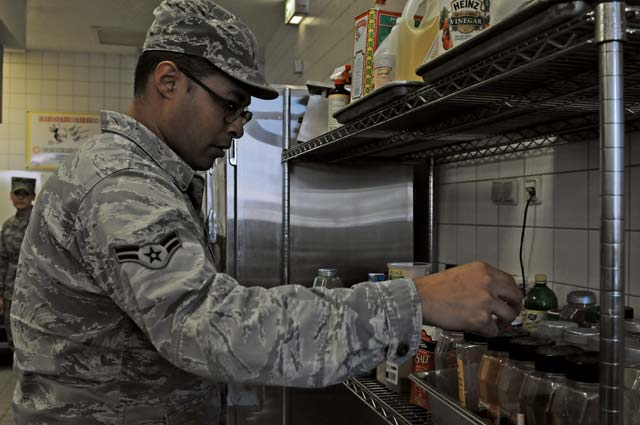
The 86th Medical Group public health flight is the first line of defense from the world’s smallest insurgents — viral and bacterial terrorist in the form of communicable disease. Keeping the public from receiving infections or diseases is its main priority.
In order to give military members and their families safe working environments, clean eating facilities and proper hearing protection for noisy work areas, the flight is broken up into different sections.
“We have occupational health, epidemiology, and food safety and sanitation,” said Capt. Amanda Huston, 86th MDG force health management and community health chief. “Each section helps prevent the spread of disease by catching it at the source.”
Each unit plays a vital role in keeping military members safe at their job and their eating facilities clean. Breaking the chain of infection is a key factor to staying healthy. Without a safe environment and sanitary food to eat, people would be more vulnerable to catching a virus or developing a physical injury.
“We try to break the chain of infection first so Airmen are mission ready at all times,” said Senior Airman Angela Seifert, 86th MDG public health technician. “In epidemiology, we surveillance portable diseases like lime disease, tick viruses and sexually transmitted diseases.”
Interviewing patients who think they are showing symptoms of a portable disease and then finding a solution could end the situation before it escalates. In order to stop the illness at its lowest level, patients need to report it when they start showing signs of infection.
“If someone is showing signs of having an infection they can call and schedule an appointment,” Seifert said. “During the appointment, we will interview them to see what exactly is wrong and then determine if they need treatment.”
Seeking proper treatment for communicable diseases is extremely important, but it’s not the only danger Airmen of the public health flight want to eradicate. Many Airmen here work in hazardous environments that can pose threats to their health in other ways, such as potential hearing loss.
“Out of the 3,800 members in our hearing program, there are 1,800 people who require hearing tests,” said Staff Sgt. Lyndell Logan, 86th MDG NCOIC of occupational health. “We test on average 300 members per month.”
Members must receive an initial hearing test prior to starting their job. This test is to collect their beginning hearing scores.
“We judge a person’s hearing throughout their career based off the score of their initial hearing test,” Logan said. “A member must take a hearing test every year after their initial test to see if their hearing has gotten worse or stayed the same.”
A hearing test lasts for 8 to 12 minutes, but if a person’s hearing has gotten worse they will be looked at further. When this happens it is considered a significant threshold shift. If the hearing is still bad after the follow up test then they may have to take a 14-hour noise free audiogram.
“During the audiogram the patient is kept away from loud noises so we can test their hearing even closer,” said Logan. “If their hearing is still bad they may be sent to Landstuhl Regional Medical Center for further testing.”
Once further testing has been done, more information for treatment will be given to the patient. A good way to keep problems like this from escalating is to get tested regularly if you work in a noisy work area. This is a method used by the food safety and sanitation office. Random inspections of eating establishments on bases in the KMC give an accurate rating of how safe and clean they are on a daily basis.
“We average 50 to 70 random inspections per month,” said Airman 1st Class Christopher Blount, 86th MDG public health technician. “At each inspection, we make sure the facility is compliant with the Food and Drug Administration guidance.”
During an inspection, they must make sure the facility is clean and the employees are practicing good food handling techniques, wearing hair nets and gloves, and are of good health while at work. Not meeting the standards is considered a discrepancy. Having too many could be considered a health hazard.
“If a discrepancy can be fixed on site, it will not be counted against them,” Blount said. “We inspect 97 public facilities in the KMC and all temporary food booths that are used at events. We do this to make sure people are getting food that is made and served properly so they don’t get sick.”
Along with random food inspections, the food safety and sanitation office also provides food recall information to food distributors and anyone who sells food on base. Giving this information to the distributers could stop consumers from receiving bad food.
Whether it’s getting tested for portable diseases, hearing tests or inspecting food establishments on base, the Airmen of the public health flight are here to keep military members, their dependents and civilians healthy. The next time you go to work or out to eat, remember that public health is doing its part to break the chain of infection.


